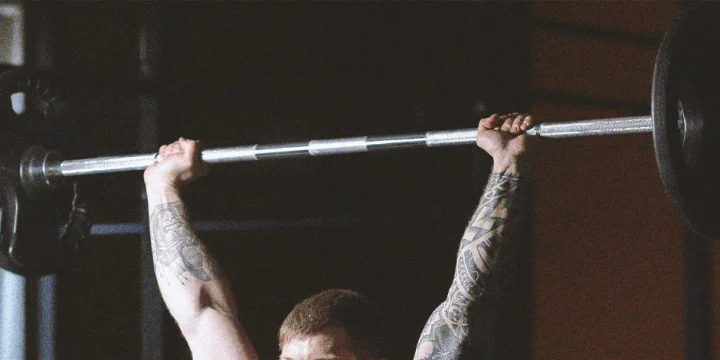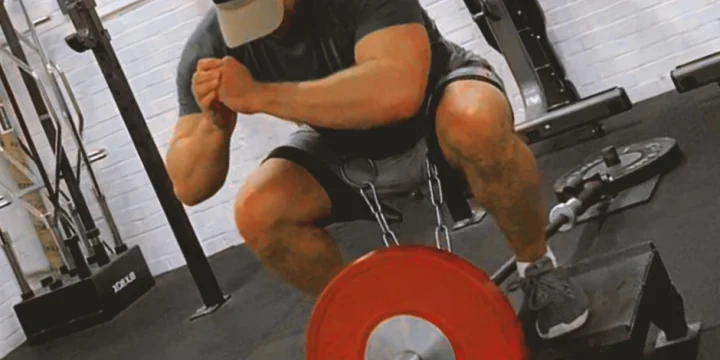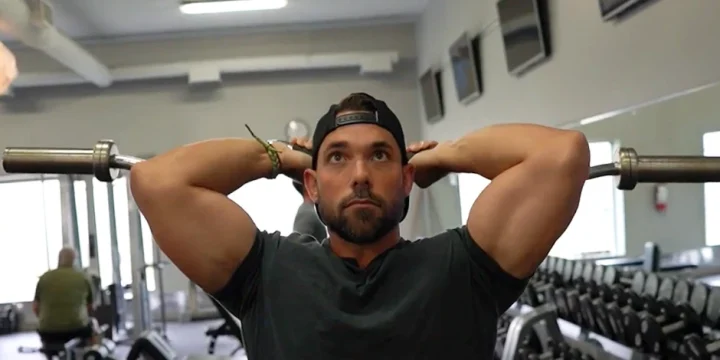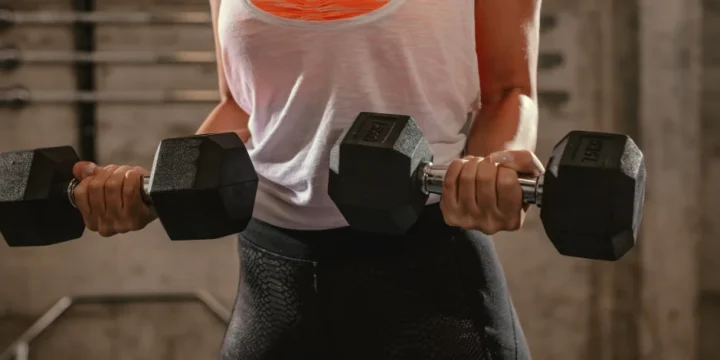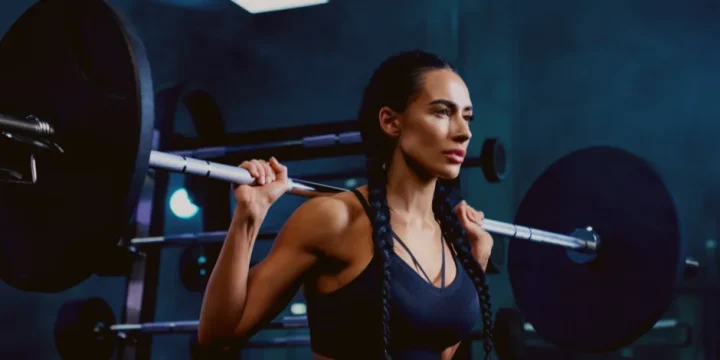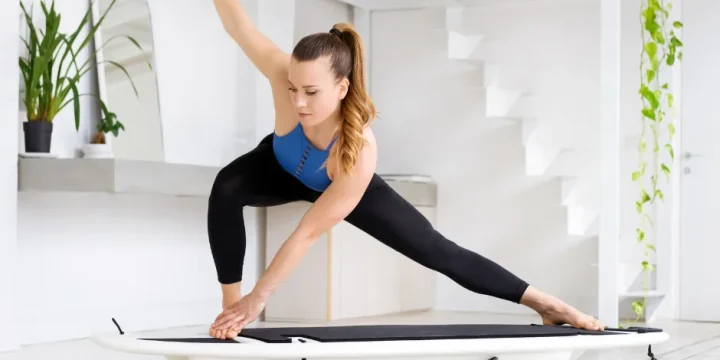The strict press is among the overhead press movements that are often confusing for many gym enthusiasts, including some of my clients.
As a certified personal trainer, I often have to explain the movement differences between a push press, a military press, and a strict press.
So, with the help of a physical therapist, I decided to settle this matter by detailing how to do a strict press, including the muscles worked and common mistakes to avoid when doing it.
Here's what you need to know.
Quick Summary
- The strict press workout, involving lifting weights from a front rack position directly overhead, focuses on strengthening the shoulders, upper back, chest, biceps, and triceps without leg involvement.
- The key to performing the strict press correctly is maintaining a steady stance, avoiding common mistakes like arching the back, and ensuring the bar path is straight.
- According to the Cleveland Clinic, the deltoid muscles, which are crucially engaged in strict press workouts, consist of three parts (anterior, lateral, and posterior delts) and are responsible for various arm movements, with 18 to 26% of adults experiencing shoulder pain at some point in their lives, highlighting the importance of proper form in exercises like the strict press.
- Based on my extensive experience as a fitness trainer, I've consistently observed that strict press workouts are essential for developing comprehensive upper body strength, contributing significantly to overall physical fitness and posture improvement.
How to Do the Strict Press

Also known as a shoulder press, the strict press involves lifting a barbell or a pair of dumbbells from a front rack position directly overhead using your upper body strength.
Your knees and legs remain steady throughout the movement.
The key difference with other overhead press movements, such as the push jerk and push presses, is that no leg drive is involved.
So no bending of knees and spinning to help the bar move overhead.
Below is a step-by-step guide on how to do this overhead press movement with proper form.
Setup
Start by loading the barbell on the J-hooks of your rack. Set it at shoulder height, then load weight plates on the bar.
Hold it slightly wider than shoulder-width apart while keeping your arms vertical. Any wider than that will form a W shape with your arms and body, which is not what we want here.
Ensure the bar rests on the meaty part of your palms while your elbows are slightly in front of the bar.
Now step back from the rack while holding the bar and take a hip-width stance.
Brace
Hold the bar across your front delts and look straight ahead.
Engage your core, squeeze your shoulder blades, and lift your chest to create a stable base.
After slightly lifting your chest, tuck your chin by moving your head back and out of the way. This is your starting position.
Press

Drive your arms up while straightening the elbows to move the bar directly overhead.
Ensure the bar path is straight, keeping your chin tucked and core tight throughout the upward movement.
Immediately after the bar is past your forehead, bring your neck back to its normal position by slightly pushing your head through your arms.
Pause briefly once your arms are fully extended overhead. Then slightly shrug your shoulders to lock the lift.
Receive
Slightly tuck your chin again as you move downward by bending your elbows and slowly returning the bar to its initial position.
In the downward movement, you're at liberty to use your legs. So, if the weight is heavy, bend your knees slightly to "catch" the bar.
Training Tips

Based on my experience, below are a few tips to help you lift in the correct form:
Warm Up
In my experience, shoulder joints are prone to injury because they move in a wide range of motion.
So, before engaging your shoulder joint in moderate and heavy lifting, do some warm-up exercises involving shoulder movements.
Studies from the WebMD website show that warm-up exercises loosen up joints and can prevent the likelihood of an injury [1].
Strict Stance
The unique difference between the standing strict press and other overhead presses is that in the former, your legs are locked up in a hip-width position to prevent them from driving the weight forward.
Stay in Line

Strife to keep your body in line throughout the movement.
From a side point of view, your body should be vertical with your lower back neutral throughout the movement.
Shrug Shoulders at the Top of the Movement
Shrug your shoulders at the top of the movement to activate your upper back muscles.
Common Mistakes

As you can see, this shoulder press workout can be very detailed in movement. So, it's easy to make mistakes.
To perform perfectly, here's what you should avoid doing:
- Too wide or with a narrow grip. The correct grip position is slightly wider than the shoulder span, not any wider or narrower than that. Grabbing the bar too wide will result in a W-shape between your arms and your body, which is not what we want.
- Arching your back. Your pelvis should be in a neutral position throughout the movement. Arching it can result in an injury.
- Not letting your chest stay up. Squeeze your shoulder blades to keep your chest up throughout the movement.
- Not tucking your chin. Do not shift the bar path. The bar should move straight from your chest to directly above your head. So, keep your chin tucked throughout the upward movement.
Other mistakes you should avoid:
- Resting the bar on your fingers instead of your palms.
- Leaving your head back after pressing the bar from your forehead upwards.
- Dropping the bar too low after the first rep.
Muscles Worked

The main muscles involved in a shoulder press include:
Deltoids
According to the Cleveland Clinic website, the deltoid muscles consist of the anterior, lateral, and posterior delts [2]. These shoulder muscles are responsible for flexing the shoulder and propelling the weight above.
Triceps
While this is predominantly a shoulder lift, the triceps are also extremely important in the movement.
They take charge once the upper arm breaks level with the ground halfway through the movement. At this point, they extend the elbow upwards. They are also responsible for lockout.
Also Read: How to Get Bigger Triceps in 30 Days: The Ultimate Workout
Full Body

In my experience, strict presses require more coordination than other upper region movements, such as the bench press, because you perform it while standing.
Hence, in addition to your shoulders and triceps, this compound exercise also works your full body.
Here's how:
- The upper back stabilizes the shoulders and scapula.
- The core keeps the body in a neutral position.
- Legs provide a solid foundation.
"The strict press is a compound movement that targets the upper region pushing muscles, but it really utilizes the entire body"
- Garett Reid, CSCS, Author at Setforset.com
Read More: Best Full-Body Power Band Workouts
FAQs
What Is the Difference Between Push Presses and Strict Presses?
The difference between push presses and strict presses is that in the former, you can use some slight leg drive to move the bar overhead, while in the strict press, the only moving parts are your shoulders and arms.
Does Strict Press Work Shoulders?
Yes, the strict press works the shoulder muscles or deltoids in addition to all the major muscles in the upper region, such as the chest, upper back, biceps, and triceps.
How Does Neuromuscular Coordination and Stability Benefit from Strict Press Workouts?
Neuromuscular coordination and stability are significantly enhanced by strict press workouts, as they require synchronized muscle contractions and balance, particularly in the shoulders and arms. This focused training improves control and efficiency in upper body movements.
What Role Does the Strict Press Play in Rehabilitation and Injury Prevention?
The strict press plays a crucial role in rehabilitation and injury prevention, especially for individuals recovering from shoulder injuries. Its controlled movement and focus on shoulder muscles make it an effective exercise for safely rebuilding strength.
How Do Strict Press Workouts Impact Functional Daily Activities?
Strict press workouts positively impact functional daily activities by enhancing the ability to perform tasks that involve overhead lifting. Regular practice of this exercise contributes to improved strength and ease in daily activities requiring upper body movement.
What Variations of Strict Press Workouts Can Accommodate Different Fitness Levels?
Variations of strict press workouts can accommodate different fitness levels by adjusting weight, range of motion, and tempo. These modifications allow the exercise to be tailored to individual needs, making it accessible for beginners and challenging for advanced practitioners.
How Do Strict Press Workouts Compare to Other Overhead Pressing Exercises in Technique and Muscle Activation?
Strict press workouts differ from other overhead pressing exercises like the push press or jerk in terms of technique and muscle activation. While all target similar muscle groups, the strict press emphasizes controlled movement and strength without momentum, making it unique in its approach to muscle development.
References:
- https://www.webmd.com/fitness-exercise/benefits-of-warmup-exercises
- https://my.clevelandclinic.org/health/body/21875-deltoid-muscles
About The Author
You May Also Like
